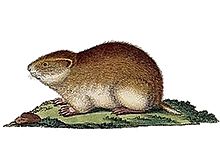
The curlew sandpiper is a small wader that breeds on the tundra of Arctic Siberia.

The Arvicolinae are a subfamily of rodents that includes the voles, lemmings, and muskrats. They are most closely related to the other subfamilies in the Cricetidae. Some authorities place the subfamily Arvicolinae in the family Muridae along with all other members of the superfamily Muroidea. Some refer to the subfamily as the Microtinae or rank the taxon as a full family, the Arvicolidae.

The Norway lemming, also known as the Norwegian lemming is a common species of lemming found in northern Fennoscandia, where it is the only vertebrate species endemic to the region. The Norway lemming dwells in tundra and fells, and prefers to live near water. Adults feed primarily on sedges, grasses and moss. They are active at both day and night, alternating naps with periods of activity.

The tundra vole or root vole is a medium-sized vole found in Northern and Central Europe, Asia, and northwestern North America, including Alaska and northwestern Canada. In the western part of the Netherlands, the tundra vole is a relict from the ice age and has developed into the subspecies Alexandromys oeconomus arenicola.

Lemmini is a tribe of lemmings in the subfamily Arvicolinae. Species in this tribe are:

The northern collared lemming or Nearctic collared lemming, sometimes called the Peary Land collared lemming in Canada, is a small lemming found in Arctic North America and Wrangel Island. At one time, it was considered to be a subspecies of the Arctic lemming. Some sources believe several other species of collared lemmings found in North America are actually subspecies of D. groenlandicus.

The southern red bat is a species of microbat found in South America.

The Amur lemming is a species of lemmings found near the Amur River in Siberia.

The genus Lemmus contains several species of lemming sometimes referred to as the true lemmings. They are distributed throughout the Holarctic, particularly in the Palearctic.

The Canadian lemming or Nearctic brown lemming is a small North American lemming.

The grey red-backed vole or the grey-sided vole is a species of vole. An adult grey red-backed vole weighs 20-50 grams. This species ranges across northern Eurasia, including northern China, the northern Korean Peninsula, and the islands of Sakhalin and Hokkaidō. It is larger and longer-legged than the northern red-backed vole, which covers a similar range and it is also sympatric with the Norwegian lemming.
The Pantanal cat is a Pampas cat subspecies, a small wild cat native to South America. It is named after the Pantanal wetlands in central South America, where it inhabits mainly grassland, shrubland, savannas and deciduous forests.

The Arctic lemming is a species of rodent in the family Cricetidae.
Middendorff's vole is a species of rodent in the family Cricetidae. It is found only in Russia, most commonly north Siberia.

The Mediterranean, Southern or Miller's water shrew is a species of insectivoran mammal in the family Soricidae.

A lemming is a small rodent, usually found in or near the Arctic in tundra biomes. Lemmings form the subfamily Arvicolinae together with voles and muskrats, which form part of the superfamily Muroidea, which also includes rats, mice, hamsters, and gerbils. In popular culture, a longstanding myth holds that they exhibit herd mentality and jump off cliffs, committing mass suicide.

The East Siberian lemming, Eastern Siberian brown lemming, or Ognev's lemming is a species of lemming endemic to Russia, where it has a disjunct distribution throughout parts of Siberia east of the Verkhoyansk Range.

The Beringian lemming or Beringian brown lemming is a species of lemming found in Russia and North America.
















